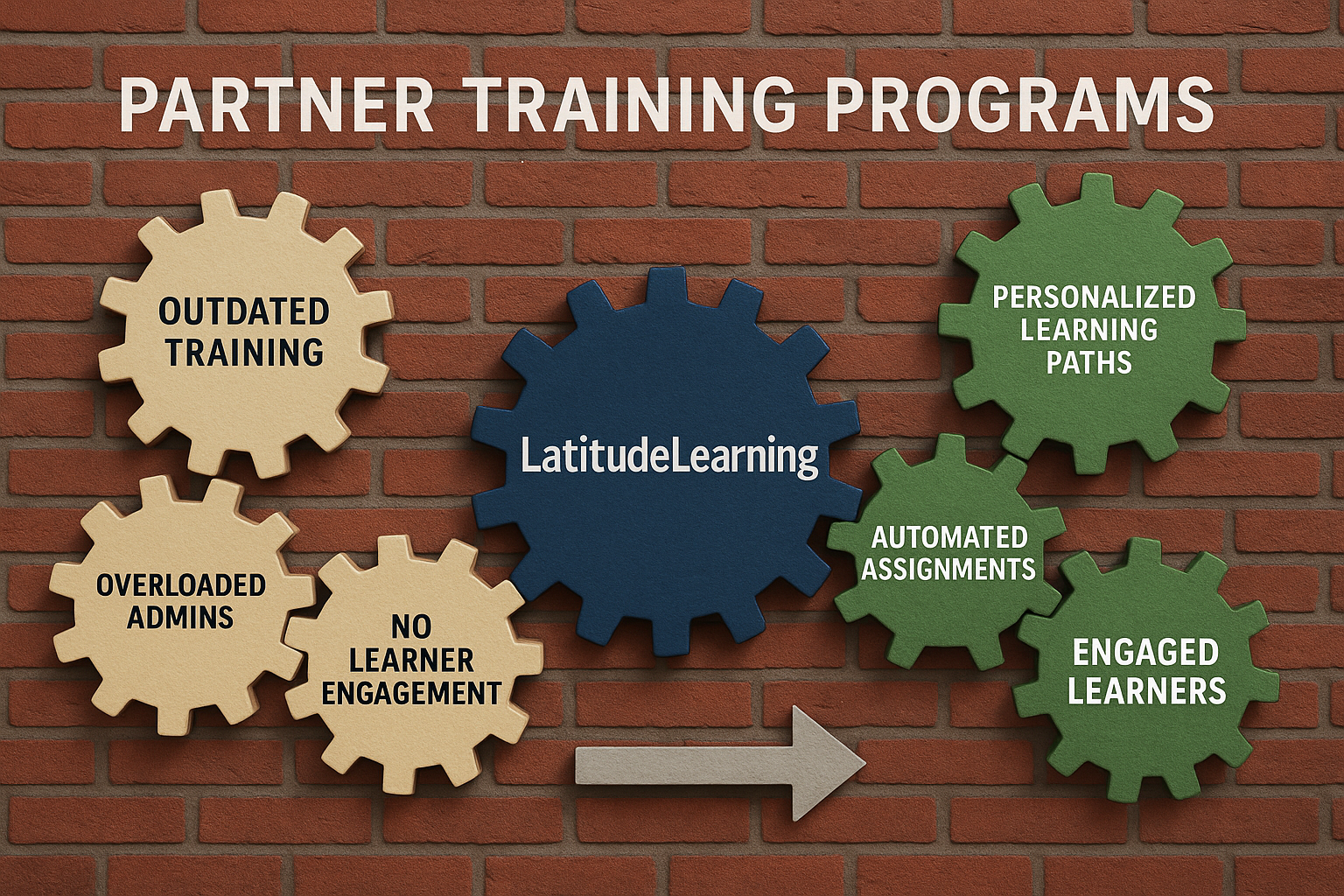Partner training programs aim to educate partner staff on selling, servicing, making, and using an organization’s products and services. Known in the learning industry as the extended enterprise, partners have specific roles such as resellers, service providers, VARs, dealers, franchisees, retailers, brokers/agents, suppliers, and customers.
Effective training can positively impact sales, profitability, installation and warranty costs, and customer satisfaction.
Many training executives struggle to enhance partner training effectiveness due to the limitations of their Learning Management Systems (LMSs), which are often designed for employee training rather than partner training. Understanding the unique challenges of partner training and the necessary LMS functionalities can help executives choose an LMS that optimizes training effectiveness and minimizes administrative costs.
This article highlights nine challenges common to partner training and the way your LMS should address them.
1. Large Partner Networks
Partner networks can encompass hundreds or even thousands of locations globally. These networks usually consist of a multitude of subnetworks, each with their own unique structures. For instance, North American resellers might be organized into regions and districts with a direct relationship with the organization, while EMEA (Europe, Middle-East, Africa) resellers might be organized by country and have an indirect relationship through country-specific distributors. Additionally, partners may have multiple locations spanning different partner networks. For example, a reseller might have locations in New York, London, and Tokyo, which belong to North America, EMEA, and Asia networks, respectively.
Your LMS must support multiple partner networks and enable partners to manage training across locations. Effective LMSs maintain course integrity across networks, allowing for comprehensive management and analysis of training data.
For example, if the SALES101: Introduction to Sales course is offered to North America, EMEA, and Asia partner networks, your LMS must be able to recognize it as the same course, enabling unified tracking and analysis.
2. Brands and Product Lines
Not all partners sell and service every brand or product at each location. To ensure each location’s staff receives proper training, your learning platform must handle brand-specific training.
For example, an Original Equipment Manufacturer (OEM) might have service providers in Dallas and Houston, each servicing different product lines. The service technicians at each service provider’s location need training only on the products that location services.
Your LMS should associate brands and products with courses, certifications, skills, and partner locations. This allows for assigning the right brand-specific training to the right partner staff and automatically adjusting certification and skill requirements based on the brands supported at each location.
Extended
Enterprise
Learning
Building Capabilities and Driving Performance Across the Value Chain
Get the eBook3. Complex Certifications
Requiring employees to take training is straightforward, as it can be a condition of employment. However, requiring partner staff to take training is more challenging, since they don’t work directly for your organization.
Partner training programs often rely on certifications and incentives to address this. Certifications may include individual, team, or partner training and performance objectives. Incentives can be linked to individual, team and partner certifications to achieve the desired training and performance levels.
Your LMS should be able to create certifications that are more complex than individual course completions. It should include certification rules for:
- Required courses, skills and certifications
- Elective courses, skills and certifications
- Individual performance metrics
- Partner location performance metrics
- Team training objectives
- Partner training objectives
These certification rule types give you the ability to create sophisticated partner certifications that are aligned with your organization’s partner learning and performance objectives.
Ebook: Certification, Compliance, and Competency
4. Sophisticated Skill Profiles
A highly skilled partner network can have a dramatic impact on the performance of an organization. To create a highly skilled partner network, the skills profiles (i.e. skills and proficiency levels) for each role need to be defined.
This is complicated, because skills are more than just understanding something, they are the ability to do something at a level of proficiency. While individual skill proficiency is important, it is insufficient in achieving partner peak performance. Partners must have the optimal mix of skilled staff to achieve peak performance.
Your LMS must enable you to define skill profiles for each role and provide a mechanism for learners to demonstrate their skill. This can be achieved by enabling learners to submit a body of evidence that is reviewed, demonstrating their skill in front of a trusted reviewer (e.g. manager or third-party), or through skill-based key performance indicators.
Additionally, your LMS must allow you to define the optimal skill mix for your partners.
Access LatitudeLearning, Free for 30 Days
Put LatitudeLearning to the test.
See why it’s the best LMS for extended enterprise training.
Learn more
5. Key Performance Indicators (KPIs)
Building highly effective partner training programs requires the incorporation of individual and partner level KPIs. Individual KPIs can be used in a training program to:
- Analyze training effectiveness
- Identify learners that require remedial training
- Demonstrate learner skill proficiency
Partner KPIs can be used to in a training program to:
- Analyze optimal partner skill mix
- Analyze training effectiveness
- Identify partners that require training interventions
These KPIs ensure training aligns with real-world performance needs.
Your LMS should capture KPIs and incorporate them into certifications, skill profiles, training assignments, and reporting to provide a comprehensive view of training effectiveness and its impact on performance.
Related: The Point of Impact: Measuring the Real Effectiveness of Training Programs
6. Multiple Field Support Networks
Partners often receive support from several independently organized field support networks, such as sales, service, and training. However, not every partner is a part of every field support network.
For example, a full-service dealer might be part of the sales, service and training networks, whereas a reseller would only be part of the sales and training networks. Additionally, the field staff needs access to training of the partner staff they support. For example, sales support staff need access to the training of their partners’ sales staff, while service support staff need access to the training of their partners’ service staff.
An effective LMS must accommodate multiple field support networks, reflecting their unique structures within the overall training solution. This flexibility allows for tailored support and training that meets the specific needs of different field networks.
Additionally, it must enable field support staff to access the training of the partners’ staff they support.
7. Multi-Role Learners
Learners frequently take on multiple roles within a partner organization and may work for multiple partners. Their training must be unified for ease of use but segregated for managers and partners.
For example, a learner might be a sales person and service technician at one partner but moonlight as a parts manager at another partner. The learner should see a comprehensive list of all the training assigned to them, but each of the three managers they work for should only be able to manage the training they assigned.
An effective LMS should allow learners to have multiple profiles and roles within a profile. It should allow each profile to be associated with a partner and each role to be associated with a manager. This enables the LMS to support the complex multi-role relationships often found in partner networks. The LMS can then present the learner a unified view of all the training that has been assigned to them, while accommodating the needs of multiple managers and partners.
8. Internal & External Learners
The focus of extended enterprise training programs is predominately training people on how to sell and service an organization’s products and service. However, even though partner sales and service channels account for the majority of an organization’s sales and service, there are often internal sales and service channels.
For example, manufacturers will often sell their products through a reseller network but maintain an in-house “national accounts” sales team. Another example is retailer franchisors that often have a number of company-owned stores staffed by employees.
Complicating the situation is the fact that these employees need career development and corporate compliance training as well as product sales and service training.
An effective LMS should configure employees as another learner audience, with both unique and shared training content, ensuring comprehensive training coverage. You should also be able to tailor its workflows to the unique needs of employees.
9. Audience-Specific Workflows
Large-scale training programs must cater to diverse learner audiences. To optimize effectiveness, training administrators need flexible tools to define and manage these audiences based on various criteria, tailoring the learner workflows accordingly.
An effective LMS should offer numerous tools to define learner audiences and customize the user experience for each group, ensuring that the training is relevant and engaging for all learners.
Choosing the Right LMS for Your Partner Training Needs
Partner training programs have the potential to dramatically impact organizational performance, but they pose a unique set of challenges. Understanding those challenges, how they impact your partner training program, and the necessary LMS functionality needed to address those challenges can help you choose an LMS that optimizes the impact of your partner training program.





